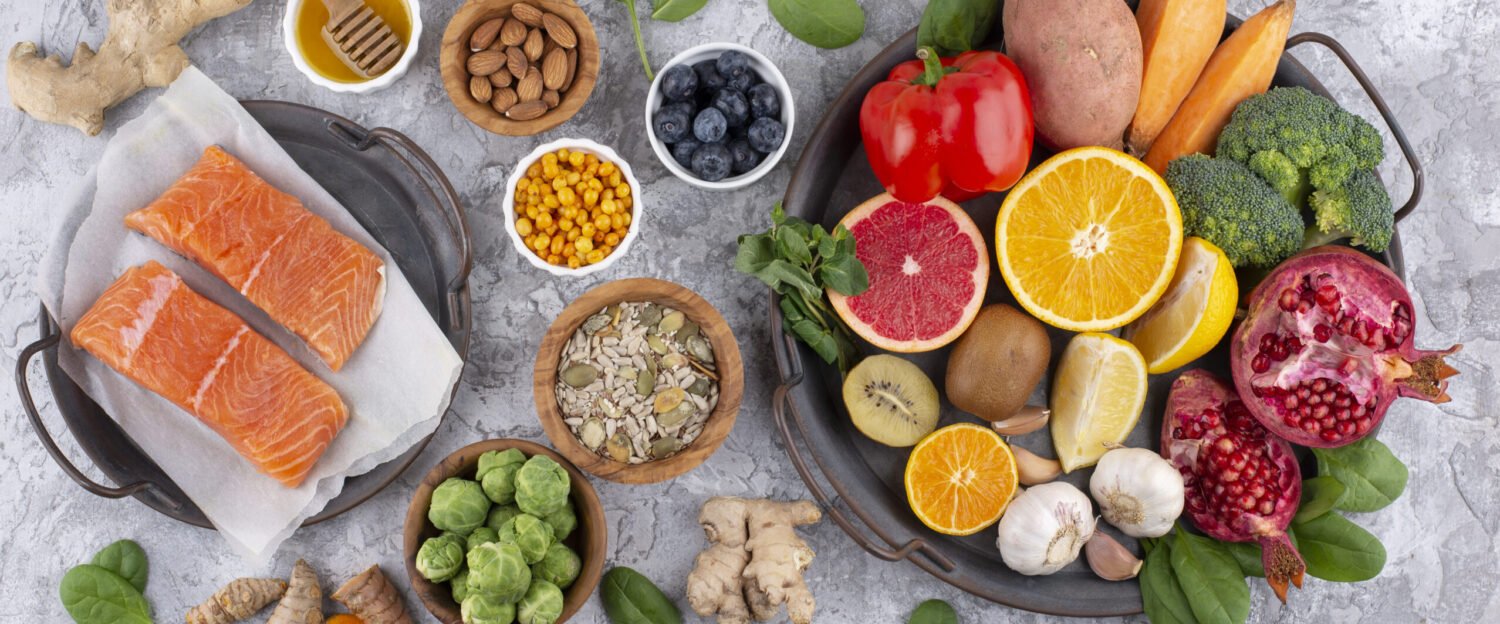Table of Contents
Introduction:
A Flower garden typically refers to a cultivated area where various types of flowers and plants are grown for ornamental and aesthetic purposes. These gardens are designed to showcase the beauty and diversity of flowering plants, often arranged in an artistic and harmonious manner. Floral gardens can range from small backyard gardens to large public botanical gardens.
Key Points to grow a flower garden:
- Diverse Plant Selection: Flower garden often include a wide variety of flowers, plants, and shrubs, chosen for their color, fragrance, and overall visual appeal. Different seasons may bring different blooms, ensuring a changing and dynamic landscape.
- Design and Layout: The layout of a Flower garden is carefully planned to create a visually pleasing and harmonious environment. Design elements may include pathways, borders, and focal points to guide visitors through the garden.
- Color Schemes: Many Flower garden are designed with specific color schemes to create a cohesive and attractive appearance. Some gardens may focus on a specific color palette, while others may showcase a rainbow of hues.
- Fragrance: Fragrant flowers are often incorporated into Flower garden to enhance the sensory experience. Visitors can enjoy the pleasant scents as they wander through the garden.
- Seasonal Changes: A well-planned Flower garden will offer different blooms and colors throughout the seasons, ensuring that there is always something of interest to see. Spring and summer are typically peak seasons for floral displays.
- Wildlife Habitat: Flower gardens can attract various forms of wildlife, including butterflies, bees, and birds, contributing to the overall ecosystem and biodiversity.
- Cultural and Educational Elements: Some Flower gardens include educational components, such as signage or guided tours, to inform visitors about the different plant species, their origins, and their cultural significance.
- Maintenance: Regular care and maintenance are crucial to keeping a Flower garden looking its best. This includes tasks such as pruning, weeding, and watering.
Flowers in garden and its English names:
ROSES:
Roses stand out as one of the most beloved and extensively cultivated categories of flowering plants.I have grown bunch roses, yellow, orange, red, pink rose in my flower garden – very charm to look at them.
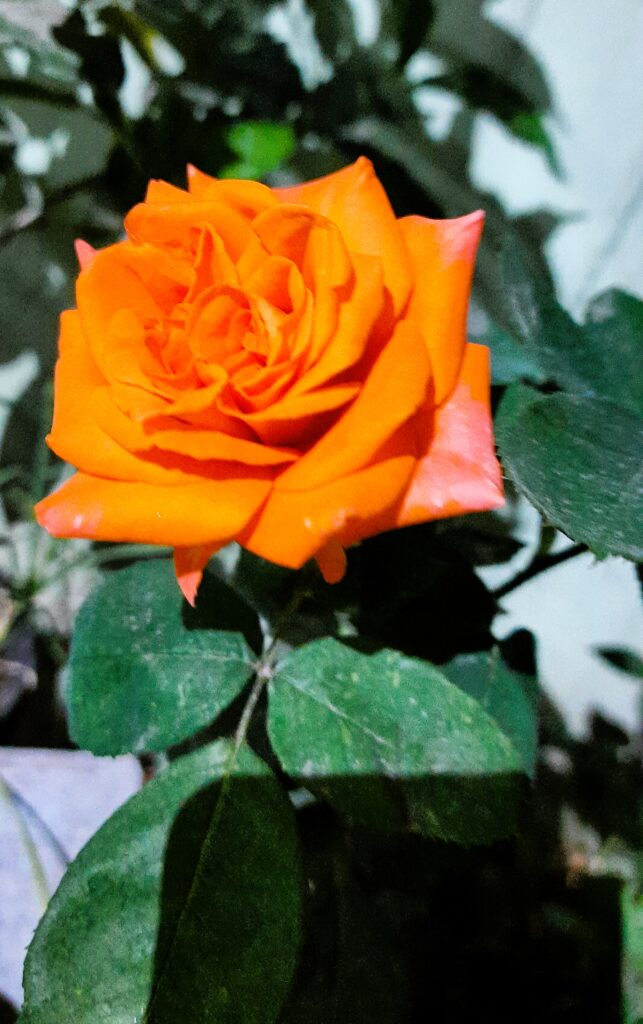
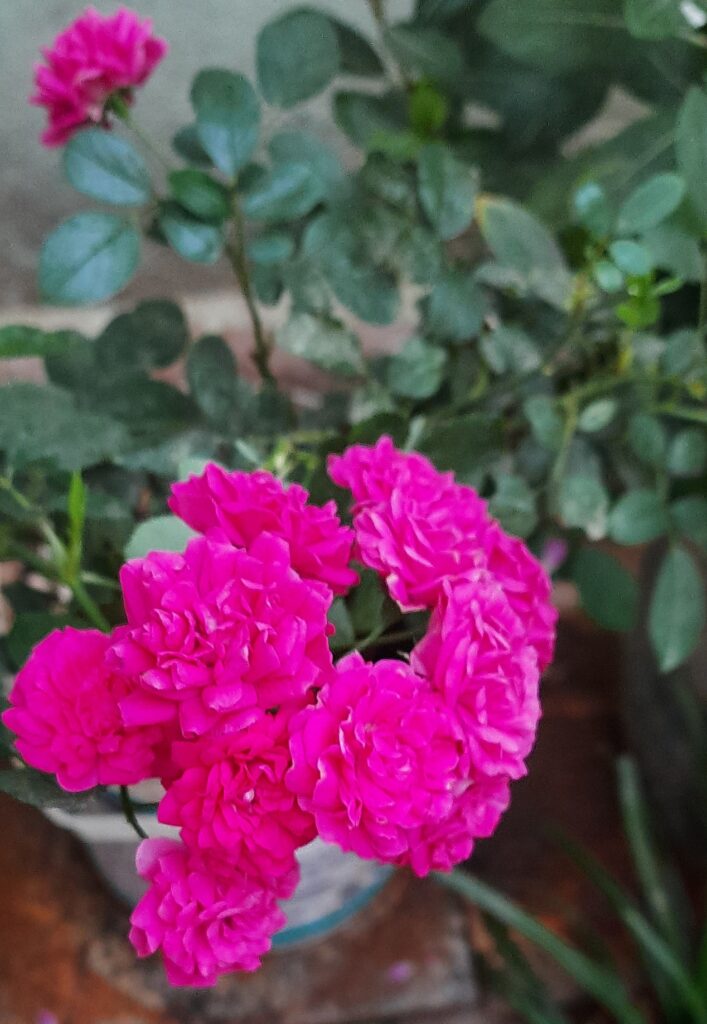
- Varieties: There are thousands of rose varieties in Flower garden, and they come in various colors, sizes, and shapes. Roses are often classified into several types, including hybrid teas, floribundas, grandifloras, climbers, and shrubs.
- Cultivation: Roses are generally hardy plants that can be grown in a variety of climates. They have a preference for well-drained soil, ideally with a slightly acidic to neutral pH. Proper sunlight, water, and care are essential for their optimal growth.
- Sunlight: Roses typically thrive in full sunlight. They require at least 6 hours of direct sunlight per day for healthy growth and abundant flowering.
- Watering: Roses prefer regular watering. Maintaining a consistently moist soil is crucial, but it’s essential to avoid waterlogging. Watering at the base of the plant rather than overhead helps prevent diseases.
- Pruning: Pruning is essential for maintaining the shape, size, and health of rose plants. Typically, this task is undertaken in late winter or early spring, just before the onset of new growth.
- Fertilizing: Roses benefit from regular fertilization during the growing season. A balanced fertilizer or one formulated specifically for roses can be applied according to package instructions.
- Disease and Pest Management: Roses can be susceptible to diseases like powdery mildew and pests such as aphids. Regular monitoring, proper spacing, and prompt treatment can help manage these issues.
- Uses: Roses are widely used for ornamental purposes, landscaping, and cut flowers. Different varieties serve different purposes, from the formal beauty of hybrid teas to the more carefree and abundant flowering of floribundas.
- Symbolism: Roses are often associated with love and beauty and are used as symbols in various cultures. Different colors of roses can convey different meanings, with red roses being particularly associated with love and passion.
HIBISCUS:
Hibiscus plants are known for their large, vibrant flowers and attractive foliage. There are different species of hibiscus, and care requirements can vary between them. Bunch of flowers bring beauty to flower garden. Two common types are tropical hibiscus (Hibiscus rosa-sinensis) and hardy or perennial hibiscus (Hibiscus syriacus). Here are general care guidelines that can apply to both types:
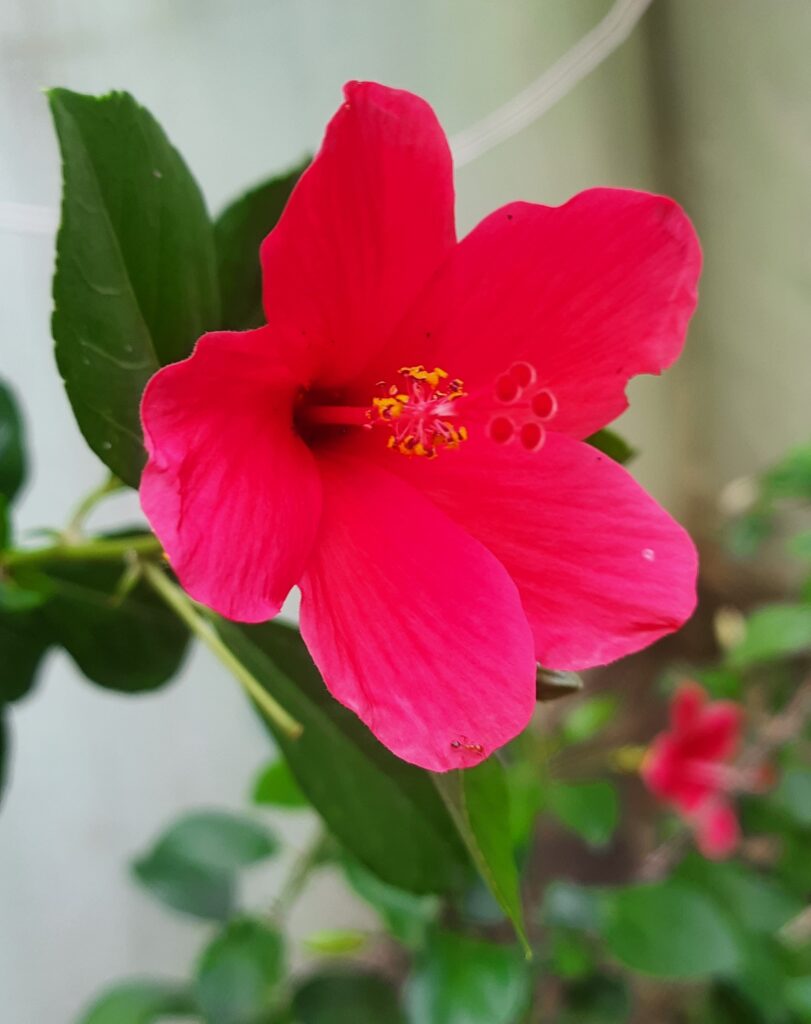
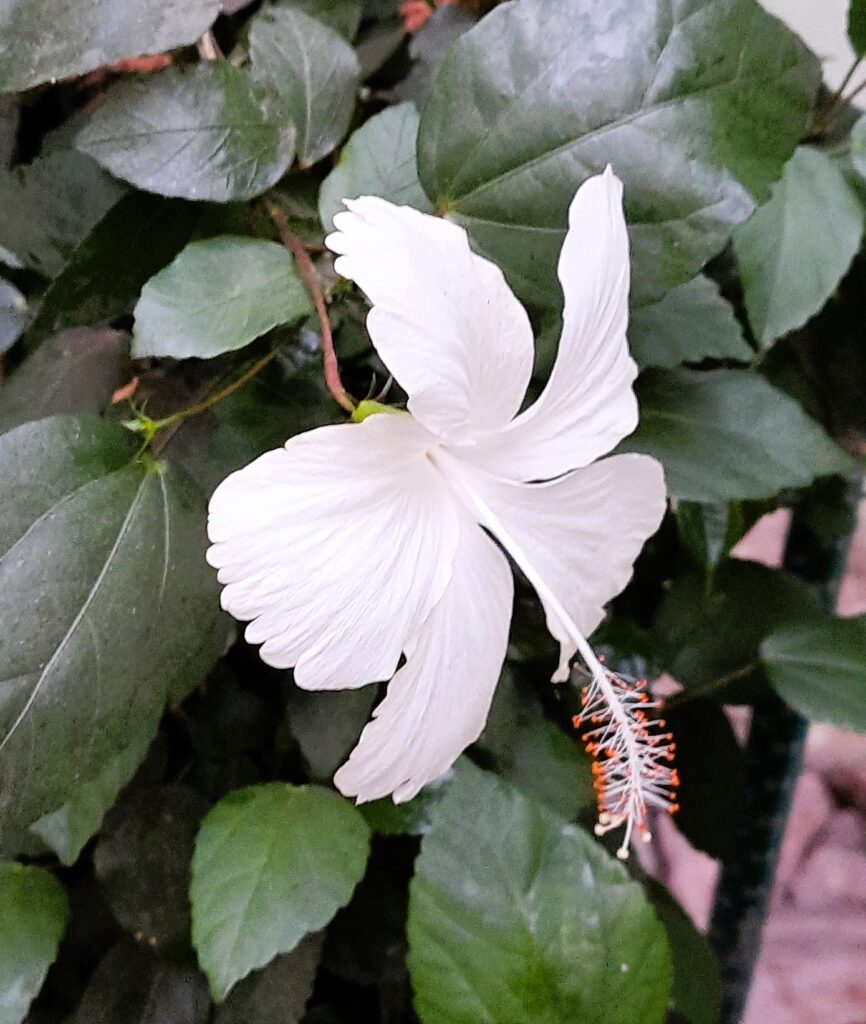
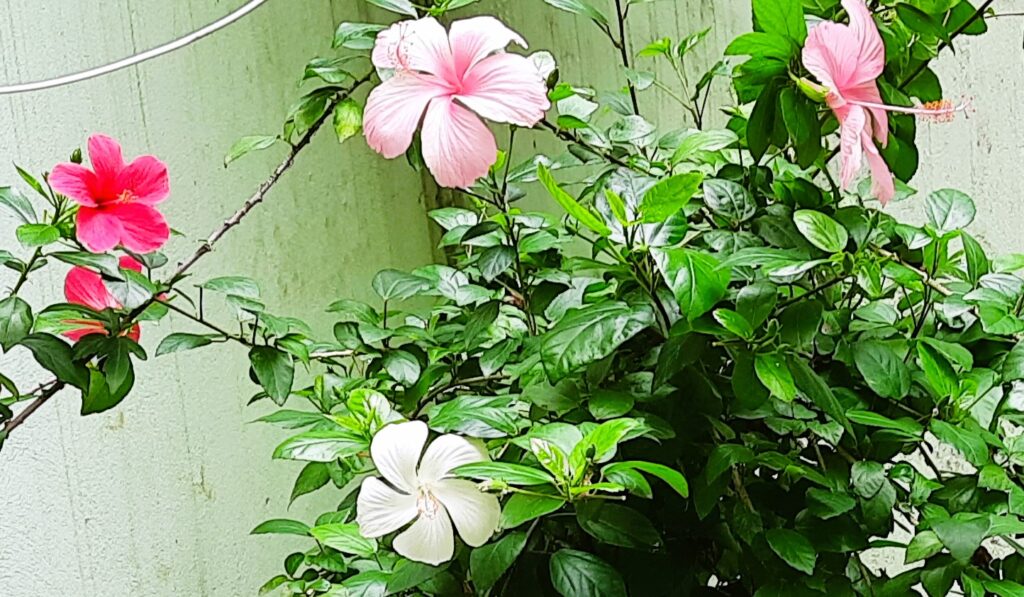
Tropical Hibiscus (Hibiscus rosa-sinensis):
- Light: Hibiscus plants thrive in full sun. They need at least 6 hours of direct sunlight daily to produce abundant flowers. Inadequate sunlight can lead to reduced flowering.
- Watering: Ensure a consistent level of moisture in the soil, particularly during the growing season. Water when the top inch of the soil feels dry, steering clear of overwatering or letting the soil become waterlogged.
- Soil: Plant hibiscus in well-draining soil with a slightly acidic to neutral pH. Use a good-quality potting mix if growing in containers. Adequate drainage is crucial to prevent root rot.
- Temperature: Tropical hibiscus prefers warm temperatures and can be damaged by cold. Protect them from temperatures below 50°F (10°C). If you live in a colder climate, consider growing tropical hibiscus in containers so you can bring them indoors during the winter.
- Fertilizing: Feed tropical hibiscus regularly with a balanced, water-soluble fertilizer during the growing season (spring and summer). Follow the package instructions for application rates, and consider reducing or halting fertilization during the fall and winter.
- Pruning: Pruning is essential for shaping the plant and stimulating branching. Promote bushiness by pinching back the tips and remove any dead or leggy branches. Typically, pruning is carried out in late winter or early spring.
- Pests: Be vigilant for pests such as aphids, spider mites, and scale. Address any infestations promptly with insecticidal soap or neem oil. Ensure proper air circulation to mitigate the risk of fungal diseases.
Hardy or Perennial Hibiscus (Hibiscus syriacus):
- Light: Hardy hibiscus prefers full sun to partial shade. It can tolerate a bit more shade than tropical hibiscus but still requires several hours of direct sunlight daily for optimal flowering.
- Watering: Maintain a consistently moist soil without allowing it to become waterlogged. During dry spells, ensure deep watering to reach the roots. Mulching is an effective strategy to retain moisture and regulate soil temperature.
- Soil: Plant hardy hibiscus in well-draining soil. They are more tolerant of various soil types but still benefit from good drainage.
- Temperature: Hardy hibiscus is more cold-tolerant than tropical hibiscus and can withstand winter temperatures. Mulch around the base of the plant in colder climates for added protection.
- Fertilizing: Feed hardy hibiscus with a balanced, slow-release fertilizer in the spring. Follow the package instructions for application rates.
- Pruning: Prune hardy hibiscus in late winter or early spring before new growth begins. Cut back old stems to encourage new growth and remove any dead or weak branches.
- Pests and Diseases: Keep an eye out for pests and diseases, but hardy hibiscus is generally less prone to insect problems than its tropical counterpart.
CHRYSANTHEMUM:
- Chrysanthemums, often referred to as mums or chrysanths, are flowering plants that belong to the Asteraceae family. Chrysanthemums are relatively low-maintenance plants that can add vibrant colors to your Flower garden. Here are some key points about chrysanthemum plants:
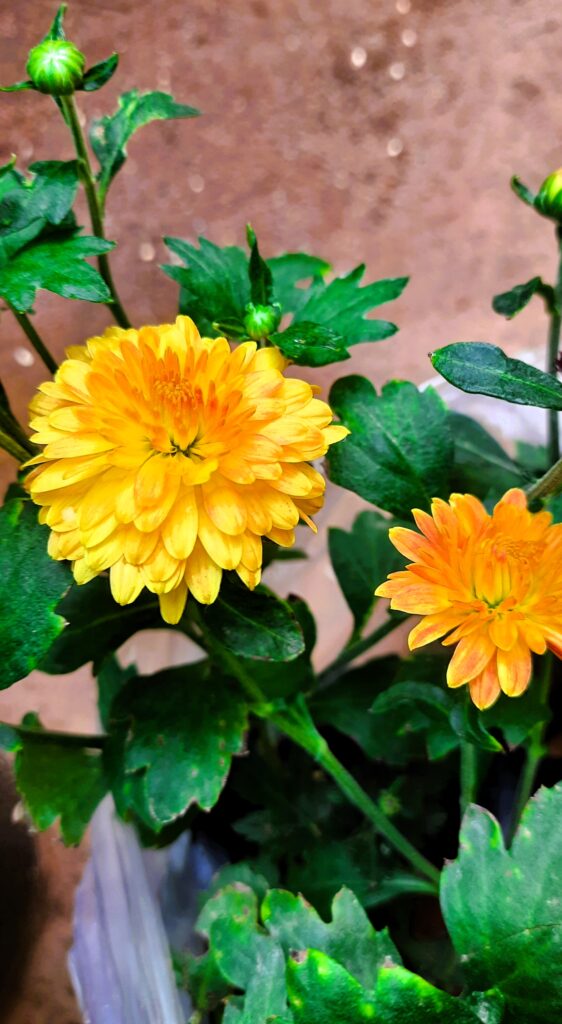
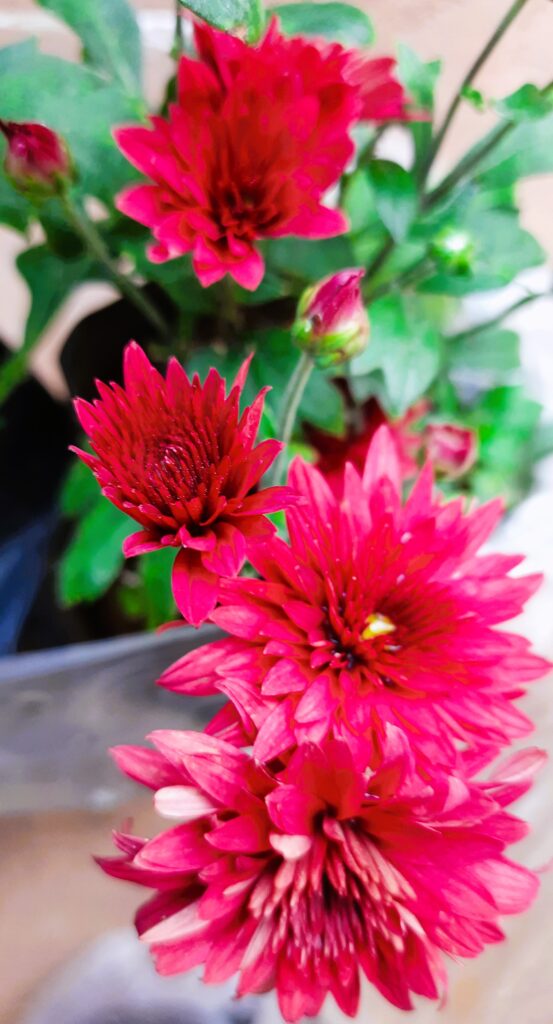
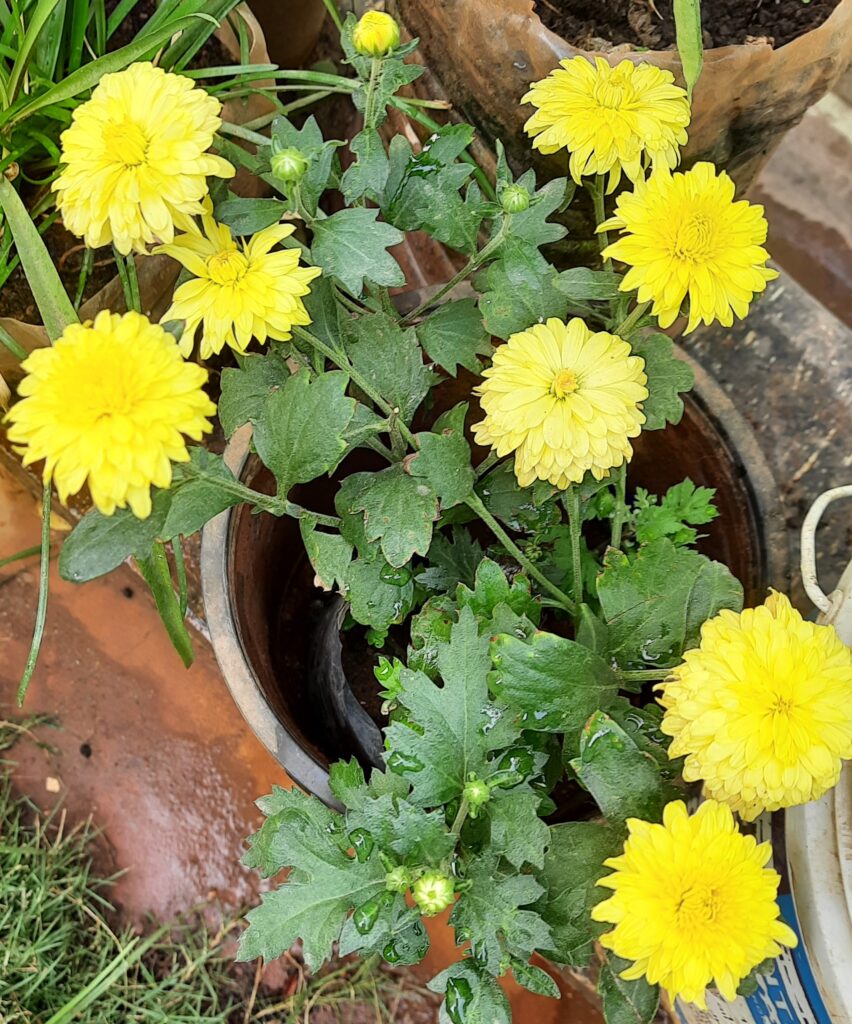
CHRYSANTHEMUM
- Varieties: Chrysanthemums come in a wide variety of colors, shapes, and sizes. There are numerous cultivars, including those with single or double blooms, and various flower forms such as pompons, daisies, spiders, and more in flower garden.
- Cultivation: Chrysanthemums are hardy plants that are commonly grown as perennials. They thrive in well-drained soil with a slightly acidic to neutral pH. For their growth and flowering, adequate sunlight is essential.
- Sunlight: Chrysanthemums generally prefer full sunlight. They need at least 6 hours of direct sunlight per day for optimal growth and prolific blooming.
- Watering: These plants prefer consistently moist soil. Watering should be done at the base of the plant to keep the foliage dry and prevent diseases. However, they do not like to sit in waterlogged soil, so good drainage is important in flower garden.
- Pruning: Regular pruning helps maintain the shape of the plant and encourages bushiness. Pinching back young shoots in spring or early summer can promote more branching and, consequently, more flowers.
- Fertilizing: Regular fertilization during the growing season proves beneficial for Chrysanthemums. A balanced, water-soluble fertilizer can be applied according to package instructions.
- Blooming Season: Chrysanthemums are known for their fall blooming season, making them a popular choice for autumn Flower garden. However, some varieties can bloom in late summer or early spring.
- Uses: Chrysanthemums are widely used for decorative purposes, both in Flower garden and as cut flowers. They are often associated with autumn floral arrangements and festivals.
- Propagating: Can be propagated through stem cutting.
- Overwintering: In colder climates, chrysanthemums may need protection during the winter.
- Helping to insulate the roots, applying a layer of mulch around the base of the plant is advisable.
- Symbolism: In various cultures, chrysanthemums symbolize different things. In general, they are associated with positive qualities such as longevity, happiness, and joy.
JASMINE:
- Jasmine is a genus of shrubs and vines in the olive family (Oleaceae) that includes a wide variety of species, many of which are known for their fragrant flowers. Flower garden will have awesome scents around when we are around the plant. Here are some key points about jasmine plants:
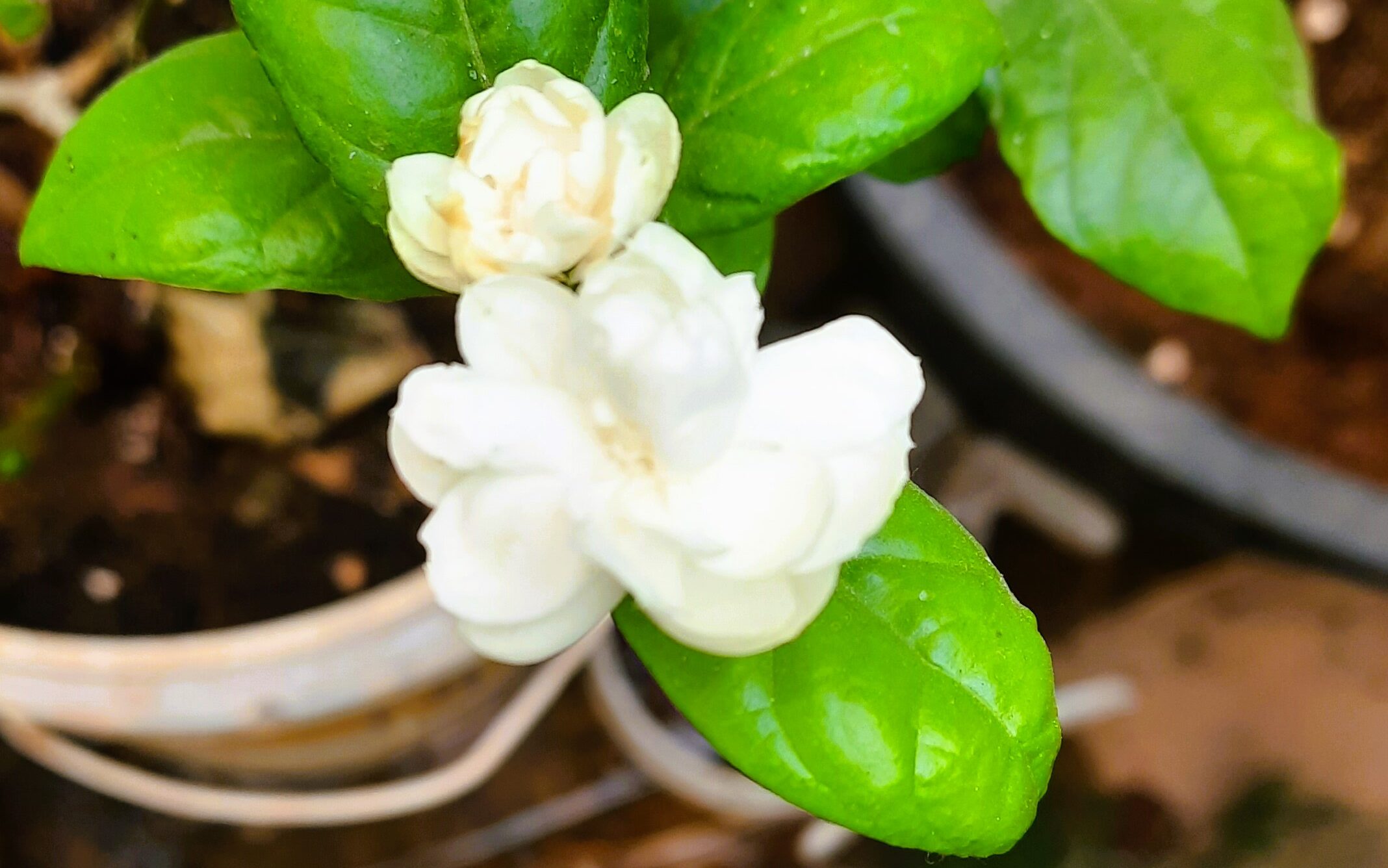
1. Characteristics:
- Fragrance: Common jasmine is well-known for its intensely fragrant white flowers. The scent is sweet and captivating in the flower garden.
- Foliage: The plant has dark green, pinnate leaves with leaflets arranged opposite each other along the stem.
2. Growing Conditions:
- Sunlight: Common jasmine prefers full sun to partial shade. It generally thrives in bright, sunny locations.
- Soil: The flower garden need well-draining soil with a slightly acidic to neutral pH is ideal for jasmine.
- Watering: Jasmine likes regular watering, especially during dry spells. Ensure that the soil stays consistently moist without becoming waterlogged.
3. Growth Habit:
- Type: Common jasmine is a woody shrub or vine, depending on how it’s cultivated in the flower garden. It can be trained to climb and cover structures like trellises or arbors.
4. Flowering:
- Blooming Season: Common jasmine typically blooms in late spring to early summer, producing clusters of small, star-shaped white flowers.
- Use in Perfumery: The flowers are highly valued in the perfume industry due to their strong, sweet fragrance.
5. Pruning:
- Purpose: Pruning is often done to shape the plant, control its size, and encourage bushier growth.
- Timing: Pruning is best done after the flowering season to avoid cutting off potential flower buds.
6. Uses:
- Ornamental: Common jasmine is widely used as an ornamental plant in flower garden on fences, and as a ground cover.
- Tea: The flowers can be used to make jasmine tea by infusing them with tea leaves.
7. Winter Care:
- Hardiness: Common jasmine is generally hardy, but in colder climates, it may benefit from protection during harsh winters.
- Mulching: Applying a layer of mulch around the base of the plant in late fall can provide protective insulation for the roots.
IXORA FLOWER:
- Ixora coccinea, commonly known as ixora, is a popular flowering shrub that belongs to the Rubiaceae family. Ixora coccinea is valued for its showy flowers, versatility, and ability to attract butterflies and hummingbirds to the flower garden. It is native to Southeast Asia but is widely cultivated in tropical and subtropical regions around the world. Here’s more information about the Ixora coccinea plant:
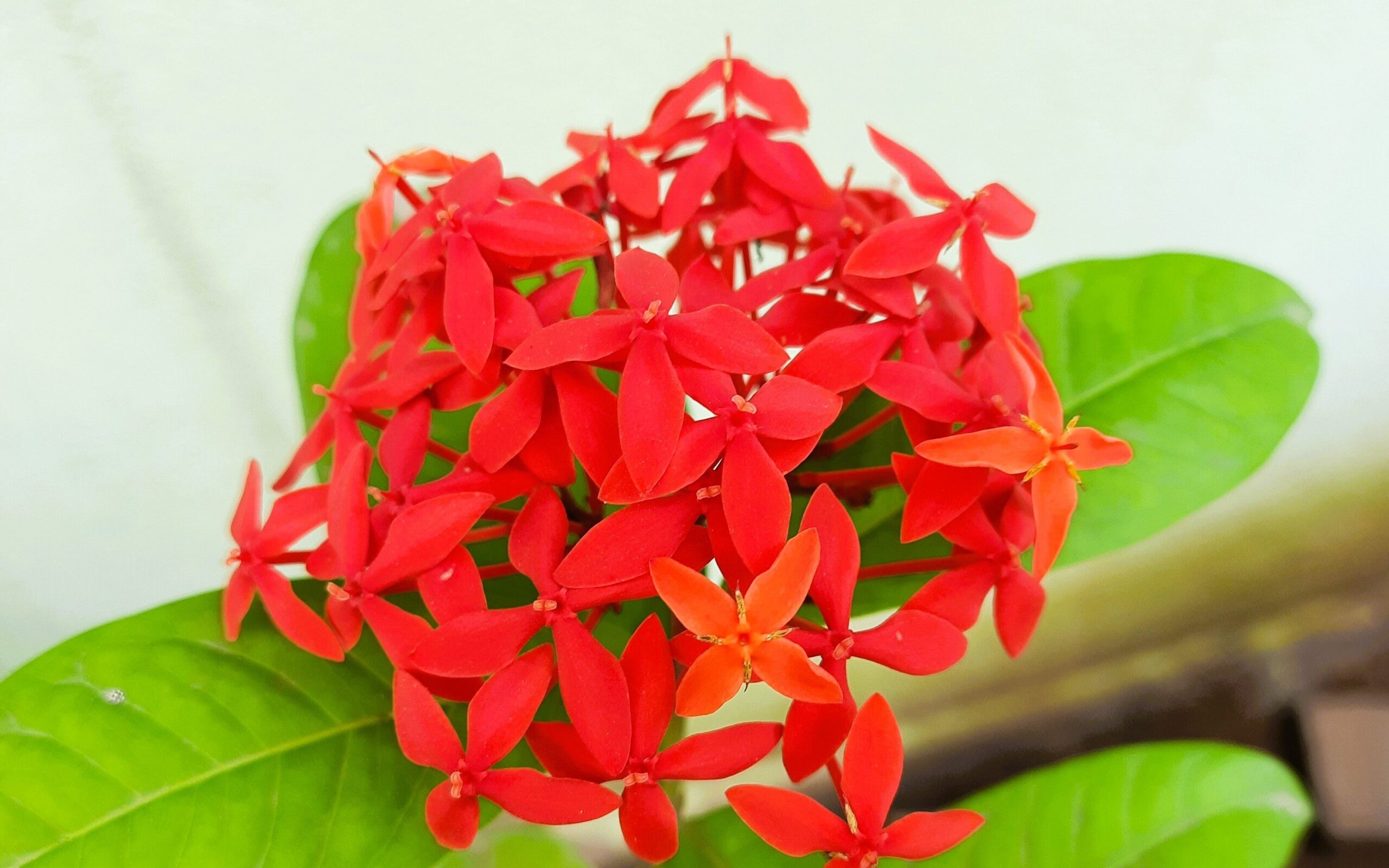
1. Characteristics:
- Leaves: Ixora coccinea has simple, glossy, and leathery leaves arranged in opposite pairs along the stem.
- Flowers: The flowers are small, tubular, and arranged in dense, rounded clusters (corymbs). They come in various colors, including shades of red, orange, pink, and yellow.
2. Growing Conditions:
- Sunlight: Ixora coccinea prefers full sun to partial shade. It generally thrives in bright, indirect light.
- Soil: Well-draining soil rich in organic matter is ideal. The soil pH should ideally range from slightly acidic to neutral.
- Watering: Maintain a consistently moist soil, avoiding waterlogging. Ixora prefers regular watering, especially during dry periods.
3. Flowering Season:
- Ixora coccinea is known for its prolific and long-lasting blooms. In favorable conditions, it can produce flowers throughout the year, with a peak during warm months.
4. Pruning:
- Pruning can help shape the plant, control its size, and encourage more flowering. It’s often done after the blooming period.
5. Uses:
- Ornamental: Ixora coccinea is widely used as an ornamental shrub in flower garden, landscapes, and as a potted plant.
- Hedge or Border Plant: It can be planted as a hedge or used as a border plant due to its dense foliage and vibrant flowers in the flower garden.
6. Varieties:
- There are several cultivars and varieties of Ixora coccinea, each with its own flower color and growth habit. Some common varieties include ‘Dwarf Red,’ ‘Super King,’ and ‘Nora Grant.’
7. Maintenance:
- Ixora plants benefit from regular feeding with a balanced fertilizer during the growing season. Applying a layer of mulch around the base of the plant in late fall can provide protective insulation for the roots.
8. Landscape Design:
- Ixora coccinea is often used in tropical and subtropical landscaping to add color and visual interest. It can be combined with other flowering plants to create vibrant flower garden displays.
9. Climate:
- Ixora coccinea thrives in warm, tropical, and subtropical climates. It may not tolerate frost and colder temperatures.
BALSAM:
- Balsam is the Impatiens balsamina, also called the garden balsam or rose balsam. Here are some key features and information about the balsam plant, specifically Impatiens balsamina:
1. Characteristics:
- Flowers: Balsam plants produce attractive, brightly colored, single or double flowers. The flowers can come in various shades, including pink, red, purple, and white.
- Leaves: The leaves are green, lance-shaped, and arranged alternately along the stems.
- Growth Habit: Balsam plants are usually bushy and can grow to a height of about 12 to 24 inches (30 to 60 cm).
2. Growing Conditions:
- Sunlight: Balsam plants prefer partial shade to full sun. In hot climates, they benefit from some protection from the intense afternoon sun.
- Soil: Well-draining, fertile soil is ideal for balsam. They can thrive in various soil types.
- Watering: In flower garden, Keep the soil consistently moist, and balsam plants generally appreciate regular watering.
3. Flowering Season:
- Balsam plants typically have a prolonged blooming period, with flowers appearing from late spring to fall.
4. Uses:
- Ornamental: Balsam plants are commonly grown for their colorful and showy flowers. They are popular choices for Flower garden, borders, and containers.
- Cut Flowers: The flowers can be cut for floral arrangements due to their vibrant colors.
5. Propagation:
- Balsam plants can be easily propagated from seeds. They readily self-seed, and new plants may emerge in the vicinity of established ones.
6. Maintenance:
- Deadheading spent flowers can encourage continuous blooming.
- In some regions, balsam plants may act as annuals, while in others, they can behave as short-lived perennials.
7. Pests and Diseases:
- Balsam plants can be susceptible to aphids and other common garden pests. Adequate spacing and good airflow can help prevent diseases.
- BUTTERFLY PEA/Clitoria Ternatea, Gokarna:
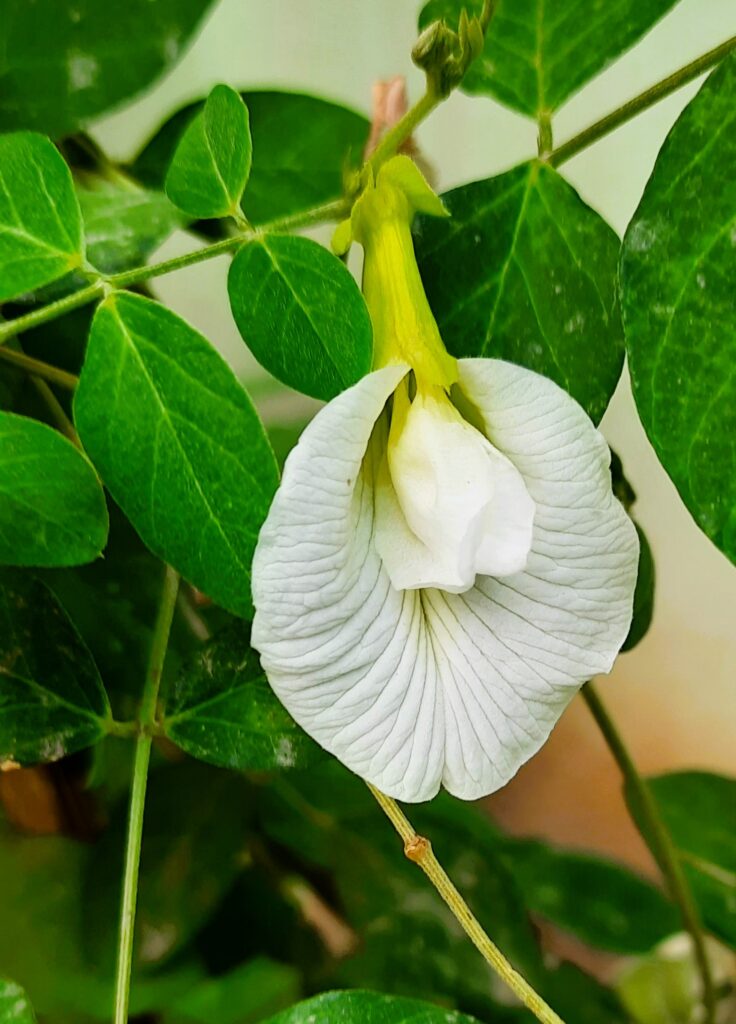
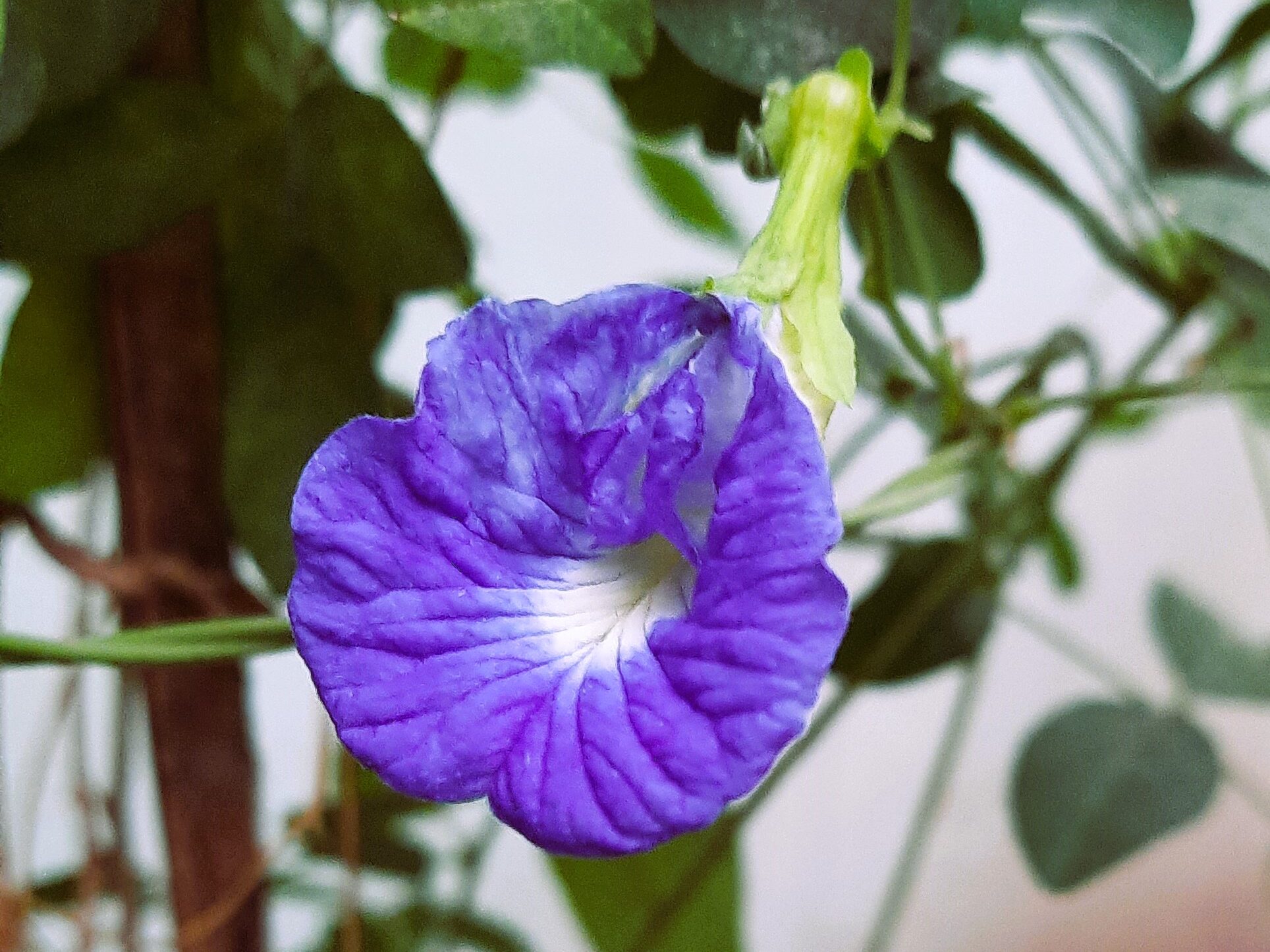
The butterfly pea plant, scientifically known as Clitoria ternatea, is a flowering vine belonging to the Fabaceae family. Native to Southeast Asia, this plant is known for its vibrant blue flowers. Here are some key characteristics and uses of the butterfly pea plant:
- Flowers: The most distinctive feature of the butterfly pea plant is its striking blue flowers. These flowers are five-petaled and have a unique shape, resembling a butterfly with outstretched wings. In addition to the blue variety, there are also white and purple varieties of the butterfly pea.
- Culinary Uses: The flowers of the butterfly pea plant are used in various culinary applications, particularly in Southeast Asian cuisine. They are known for their natural blue pigment, which is water-soluble. The flowers are often used to color rice, beverages, and desserts. The blue color can change to purple or pink depending on the pH of the substance it is mixed with, making it a versatile natural food coloring.
- Health Benefits: The butterfly pea plant is believed to have several health benefits. It contains antioxidants, and in traditional medicine, it has been used for its potential nootropic and anti-stress properties. Some studies suggest that the plant may have anti-inflammatory and anti-diabetic effects, but more research is needed to confirm these potential health benefits.
- Herbal Tea: Butterfly pea flowers are commonly used to make a vibrant blue herbal tea. The tea is not only visually appealing but is also said to have relaxing properties. When lemon or other acidic ingredients are added to the tea, the color can change from blue to purple due to the change in pH.
- Garden Ornamental: Apart from its practical uses, the butterfly pea plant is also cultivated for ornamental purposes. Its beautiful flowers make it a popular choice for gardens and landscapes.
- Nitrogen Fixation: Like other legumes, the butterfly pea plant has the ability to fix nitrogen in the soil, making it beneficial for improving soil fertility.
- Propagation: The plant can be propagated through seeds or cuttings. It typically thrives in warm and tropical climates, and it prefers well-drained soil.
Overall, the butterfly pea plant is a versatile and attractive plant with various uses, ranging from culinary applications to traditional medicine. Its unique properties make it an interesting addition to both Flower garden and kitchens.
CRAPE JASMINE:
The crape jasmine, scientifically known as Tabernaemontana divaricata, is a popular flowering shrub that is native to Southeast Asia used in flower garden. Here are some key features and information about the crape jasmine plant:
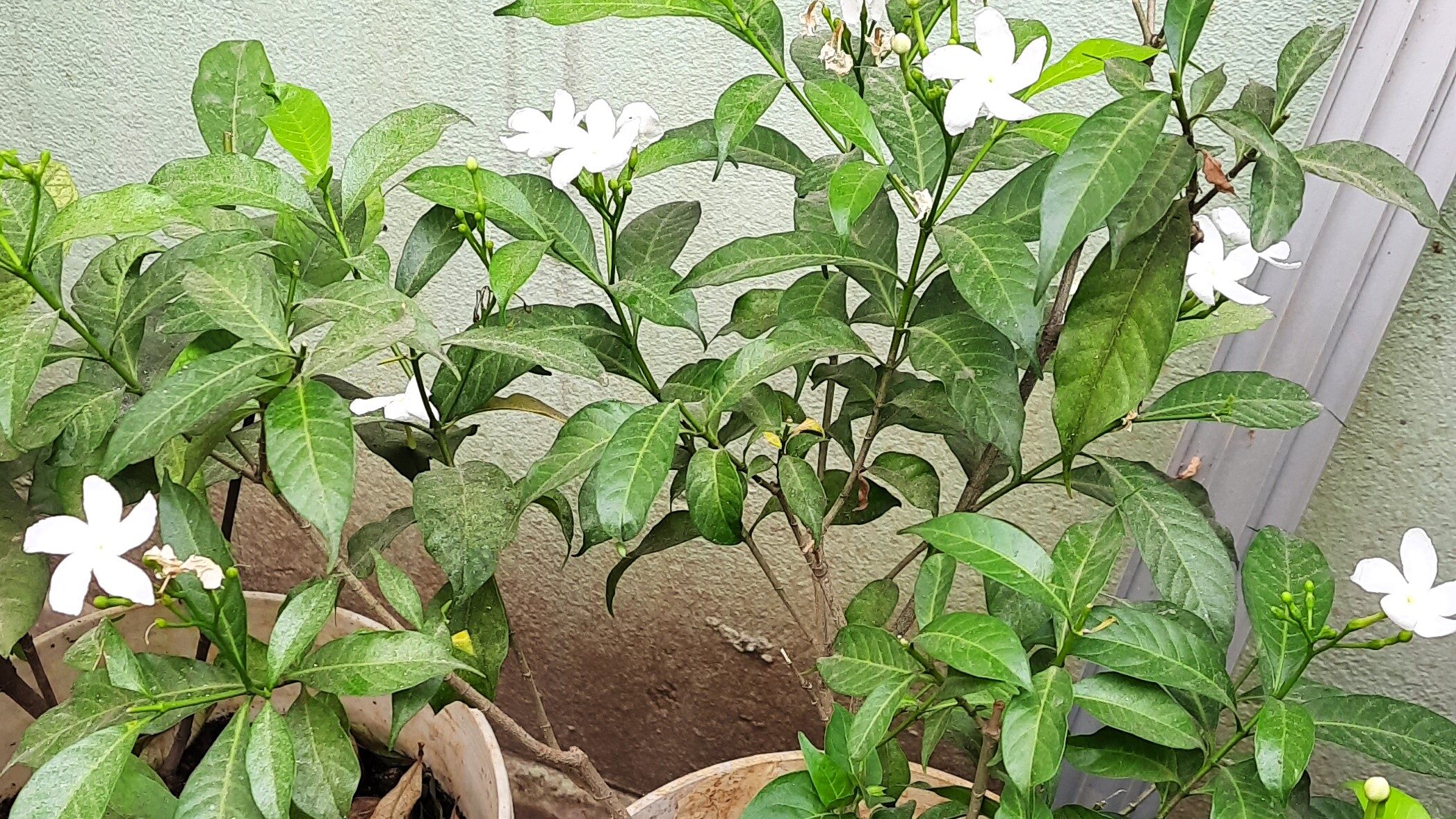
- Appearance: The crape jasmine is an evergreen shrub that typically reaches a height of 3 to 6 feet (about 1 to 2 meters) in flower garden. It has glossy, dark green leaves arranged in opposite pairs along the stems. The plant produces fragrant, white, or cream-colored flowers that resemble pinwheels. The flowers of the crape jasmine are star-shaped and tend to bloom in clusters.
- Flowering: Crape jasmine is renowned for its abundant and continuous blooming, with flowers appearing throughout the year, reaching a peak during warm months. The delightful fragrance of the blossoms makes it a favored choice for flower gardens and landscapes.
- Cultivation: Crape jasmine is relatively straightforward to cultivate and adapts well to various soil conditions. It thrives in well-drained soil and can endure both full sun and partial shade. Regular watering, especially during dry periods, contributes to its well-being.
- Uses in Landscaping: Commonly employed in landscaping for hedges, borders, and ornamental purposes, the crape jasmine is versatile. It can be pruned to uphold a desired shape and size.
- The plant’s dense foliage and attractive flowers contribute to its aesthetic appeal.
- Fragrance: The flowers of the crape jasmine are known for their sweet and pleasant fragrance, making them a favorite for gardens and outdoor spaces.
- Medicinal Uses: In traditional medicine, certain parts of the crape jasmine plant are believed to have medicinal properties. Extracts from the plant have been used in some traditional herbal remedies, although it’s important to note that the plant should be handled with care, as some parts may be toxic if ingested.
- Propagation: Crape jasmine can be propagated through seeds or cuttings. It is a relatively fast-growing plant, and with proper care, it can establish itself well in a variety of flower garden settings.
- Pests and Diseases: While crape jasmine is generally hardy, it can be susceptible to pests such as aphids and mealybugs. Regular inspection and appropriate pest control measures can help maintain the plant’s health.
Overall, the crape jasmine is a versatile and attractive shrub that adds beauty and fragrance to gardens. Its low maintenance requirements and continuous blooming make it a popular choice for both experienced and novice gardeners.
RAJINIGANDA TUBEROSE:
- The tuberose, scientifically known as Polianthes tuberosa, is a fragrant flowering plant that is native to Mexico. Here are some key features and information about the tuberose plant:
- Appearance: The tuberose is a perennial plant that grows from underground tubers. It produces long, slender stems with lance-shaped leaves arranged in a spiral pattern. The plant can reach a height of 2 to 3 feet (about 60 to 90 cm). The most distinctive feature of the tuberose is its clusters of waxy, trumpet-shaped flowers that bloom along the stems.
- Fragrance: Tuberose is renowned for its intense and captivating fragrance. The scent is sweet, floral, and often described as heady or exotic. Due to its strong fragrance, tuberose is a popular choice for perfumery and is often used as a base note in many high-end perfumes.
- Flowering: Tuberose flowers bloom in summer and continue into early fall. The flower spikes can be quite tall, and each cluster contains multiple white or cream-colored blossoms. The flowers have a tubular shape and are arranged in a spiral along the stem.
- Cultivation: Tuberose plants thrive in warm climates and are often grown in tropical and subtropical regions. They prefer well-drained soil and full sunlight. Adequate spacing between plants is recommended to ensure good air circulation. Tuberose can be cultivated in the ground or in containers at flower garden.
- Uses: Apart from its ornamental and olfactory appeal, tuberose is also used in the production of essential oils and floral absolutes. The essential oil extracted from tuberose flowers is valued in the perfume industry for its rich fragrance. In some cultures, tuberose flowers are also used in garlands and floral arrangements.
- Propagation: Tuberose is propagated primarily through bulbs or tubers. Planting these underground structures in spring will lead to flowering in the summer. The tubers should be planted at a sufficient depth to protect them from extreme temperatures.
- Maintenance: Tuberose plants require regular watering, especially during dry periods. Mulching around the base of the plants can help retain moisture and control weeds. Deadheading spent flowers can encourage the plant to produce more blossoms.
- Pests and Diseases: Tuberose plants may be susceptible to pests.
PERIWINKLE:

The periwinkle plant, known scientifically as Catharanthus roseus, is a flowering perennial that is native to Madagascar. It is also commonly known as vinca, rosy periwinkle, or Madagascar periwinkle. Here are some key features and information about the periwinkle plant:
- Appearance: Periwinkle is a low-growing evergreen shrub with glossy, dark green leaves. The leaves are arranged opposite each other on the stem. The plant typically reaches a height of 1 to 2 feet (30 to 60 cm), and it spreads by sending out trailing stems.
- Flowers: The flowers of the periwinkle plant are star-shaped and come in various colors, including shades of pink, purple, and white. The blooms are often solitary and have a distinct, five-petaled shape. The plant produces flowers throughout the growing season, adding color to flower garden and landscapes.
- Cultivation: Periwinkle is known for its adaptability and ability to thrive in different conditions. It prefers well-drained soil and can tolerate both full sun and partial shade. Once established, it is relatively drought-tolerant. Periwinkle is often used as ground cover in gardens and is valued for its ability to suppress weeds.
- Uses in Landscaping: Due to its low-growing and spreading nature, periwinkle is commonly used as ground cover in flower garden, landscapes, and along borders. It provides a carpet of foliage and flowers, helping to prevent soil erosion and suppress the growth of weeds.
- Medicinal Uses: The periwinkle plant contains alkaloids, including vincristine and vinblastine, which have been used in the treatment of certain cancers, particularly leukemia and lymphoma. These compounds have anti-cancer properties and are used in chemotherapy. It’s important to note that the medical use of periwinkle should only be undertaken under the supervision of healthcare professionals.
- Propagation: Periwinkle can be easily propagated by stem cuttings. Simply plant cuttings in well-draining soil, and they will often take root and grow into new plants. This makes periwinkle a relatively easy plant to propagate and share.
- Maintenance: Periwinkle is a low-maintenance plant in the flower garden. Regular watering is beneficial, especially during dry spells, but it is generally drought-tolerant once established. Pruning can be done to control its spread and shape if needed.
- Pests and Diseases: Periwinkle is generally resistant to many pests and diseases. However, like any plant, it may be susceptible to issues such as aphids or fungal diseases. Good garden hygiene practices and proper care can help prevent these problems in the flower garden.
PORTUCULA:
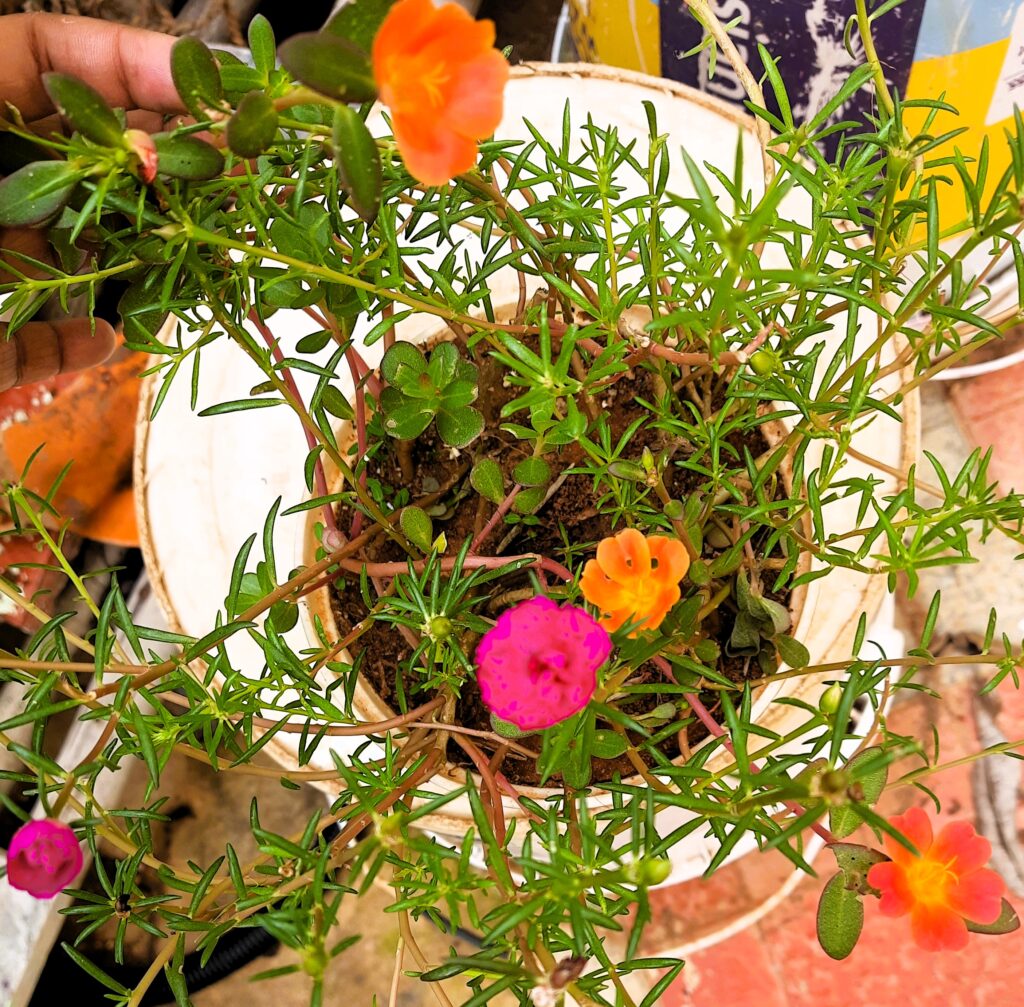
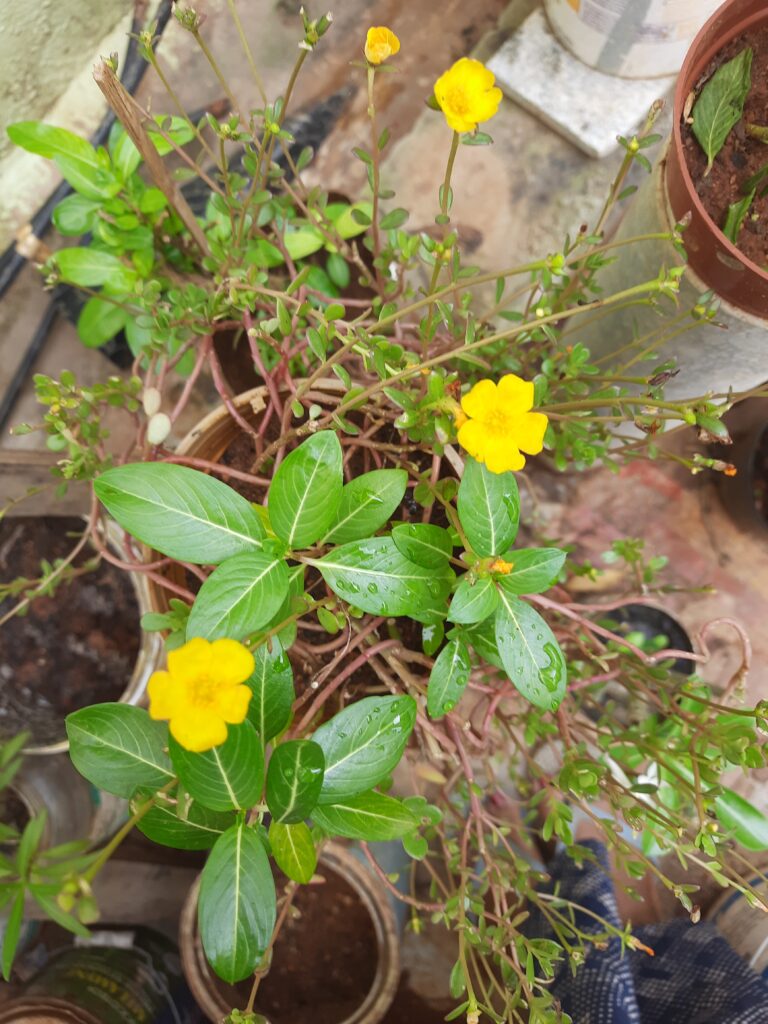
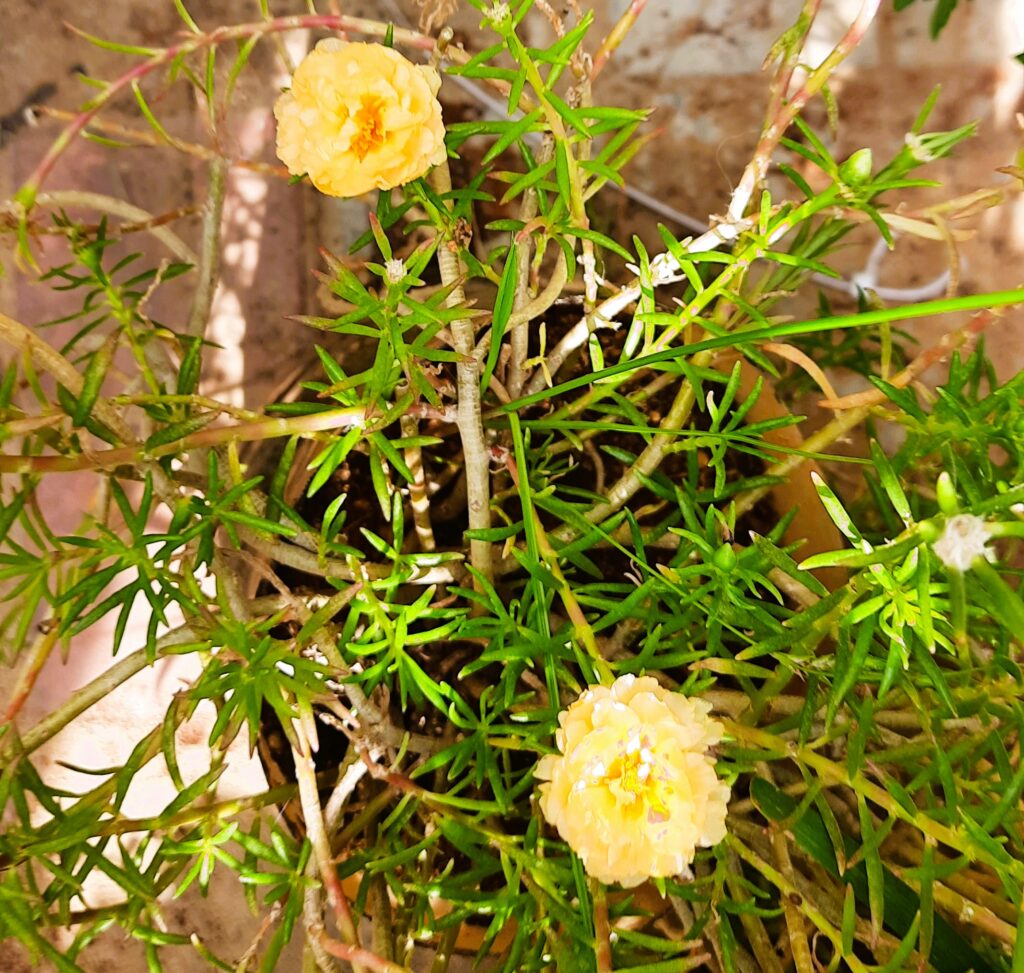
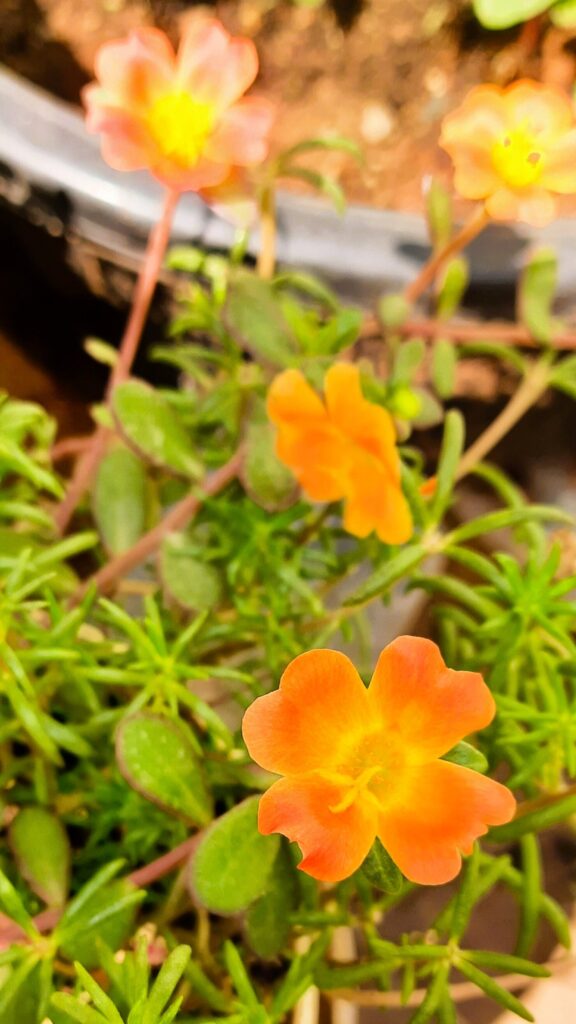
Portulaca is a genus of flowering plants that includes numerous species commonly known as purslane or moss rose in flower garden. Here is some information about Portulaca:
- Appearance: Portulaca plants are low-growing succulents with cylindrical leaves. The leaves are fleshy and have a smooth texture. The flowers are typically small, but they come in a variety of vibrant colors, including pink, red, orange, yellow, and white. The plants have a spreading or trailing habit.
- Cultivation: Portulaca is well-suited for sunny and dry conditions. It thrives in well-drained soil and is often used in flower garden, rock gardens, containers, or hanging baskets. These plants are known for their ability to tolerate hot and arid climates, making them popular choices for xeriscaping.
- Blooming: Portulaca is a prolific bloomer, and its flowers often open in the morning and close in the afternoon. The blooming period extends throughout the warm months, providing continuous color in the garden.
- Drought Tolerance: One of the notable features of Portulaca is its ability to withstand drought conditions. The succulent leaves store water, allowing the plant to thrive in environments with infrequent watering.
- Maintenance: Portulaca is generally low-maintenance. It requires well-drained soil and benefits from occasional watering, especially during prolonged dry periods. These plants are often used as ground covers due to their spreading habit.
- Use in Landscaping: Portulaca is commonly used in landscaping to add color to borders, flower garden, rock gardens, and other sunny areas. Its trailing habit also makes it suitable for hanging baskets and containers, where it can spill over the edges.
- Self-Seeding: Some Portulaca varieties are known for their self-seeding nature. This means that if allowed, the plants can produce seeds that will sprout and grow in the surrounding area.
- Edible and Medicinal Uses: Purslane, a specific type of Portulaca, is edible and has been used in some culinary traditions. It is rich in omega-3 fatty acids and various nutrients. Additionally, some species of Portulaca have been used in traditional medicine for their potential medicinal properties.
RAIN LILY:
The rain lily, scientifically known as Zephyranthes, is a group of flowering plants that are known for their charming, trumpet-shaped flowers. Here are some key features and information about the rain lily plant:
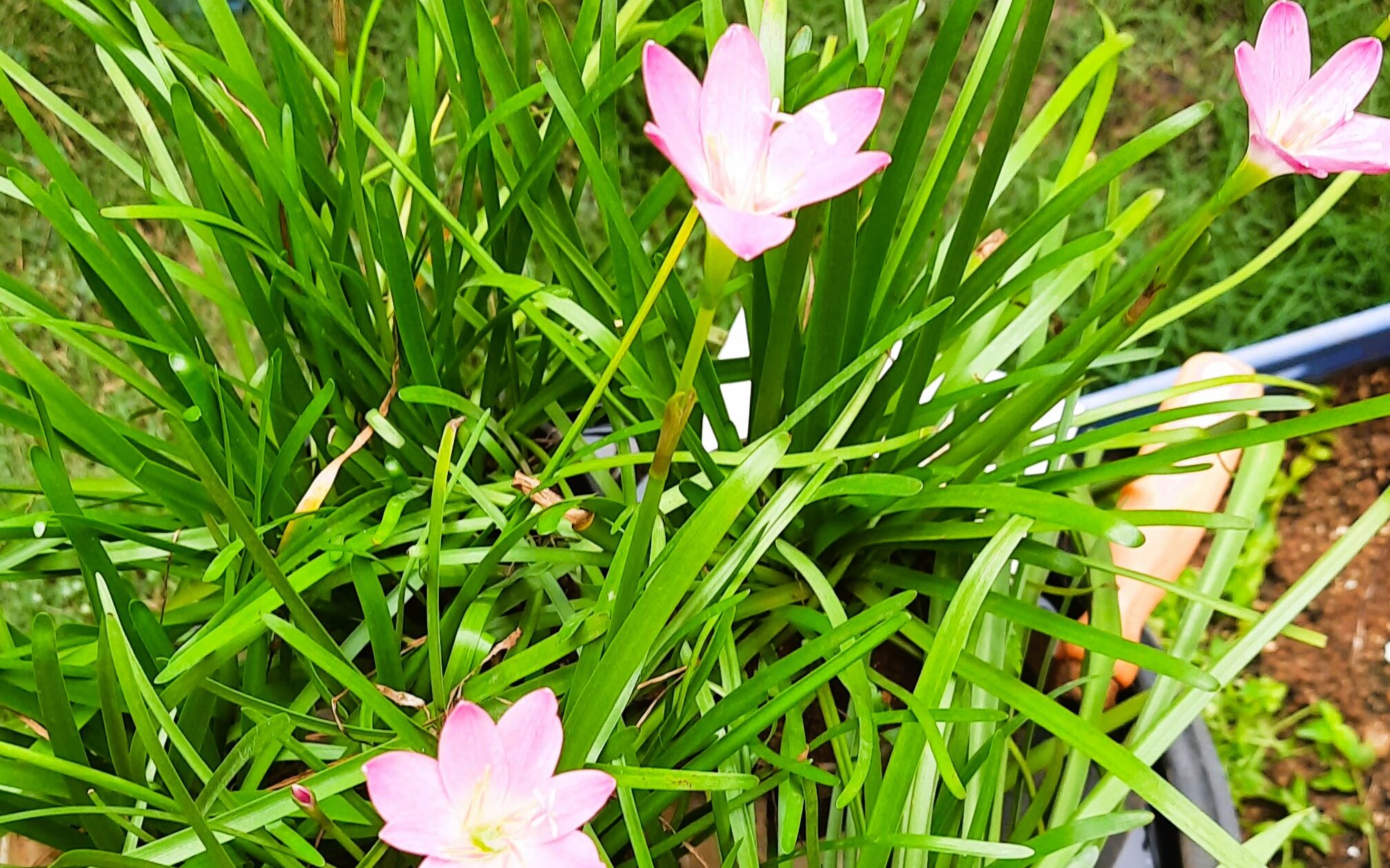
- Appearance: Rain lilies are herbaceous perennials that grow from bulbs. They typically have long, slender, grass-like leaves that arise from the base of the plant. The flowers are usually trumpet-shaped, with six petal-like segments. The flowers come in a variety of colors, including white, pink, yellow, and shades of lavender.
- Blooming: Rain lilies are often called “rain lilies” because they are known to bloom shortly after a significant rainfall. The flowers can appear individually or in clusters, creating a delightful display. While they do respond to rain, they can also bloom in response to watering.
- Cultivation: Rain lilies are relatively easy to grow. They prefer well-drained soil and are well-suited for both garden beds and containers. They thrive in full sun to partial shade, depending on the specific species or variety. The bulbs should be planted at a depth of a few inches.
- Season: Depending on the species, rain lilies may bloom during different times of the year. Some varieties bloom in late spring to early summer, while others bloom in late summer to early fall. The blooming period can be prolonged, with intermittent blooms occurring under favorable conditions.
- Varieties: There are several species and hybrids of rain lilies. Some common species include Zephyranthes candida (white rain lily), Zephyranthes rosea (pink rain lily), and Zephyranthes citrina (yellow rain lily). Each species may have slightly different characteristics, including flower color and size.
- Propagation: Rain lilies can be propagated by dividing the bulbs. This is typically done when the plant becomes crowded, and it’s time to rejuvenate or share the plant. The bulbs can be separated and replanted in new locations of flower garden.
- Low Maintenance: Rain lilies are generally low-maintenance plants in the flower garden. They don’t require extensive care once established. Adequate water during their growing season and occasional fertilization can promote healthy growth and blooming.
- Use in Landscaping: Due to their small size and attractive flowers, rain lilies are often used in landscaping as border plants, in flower garden, or as container plants. They add a touch of color and charm to various outdoor settings.
PEACELILY:
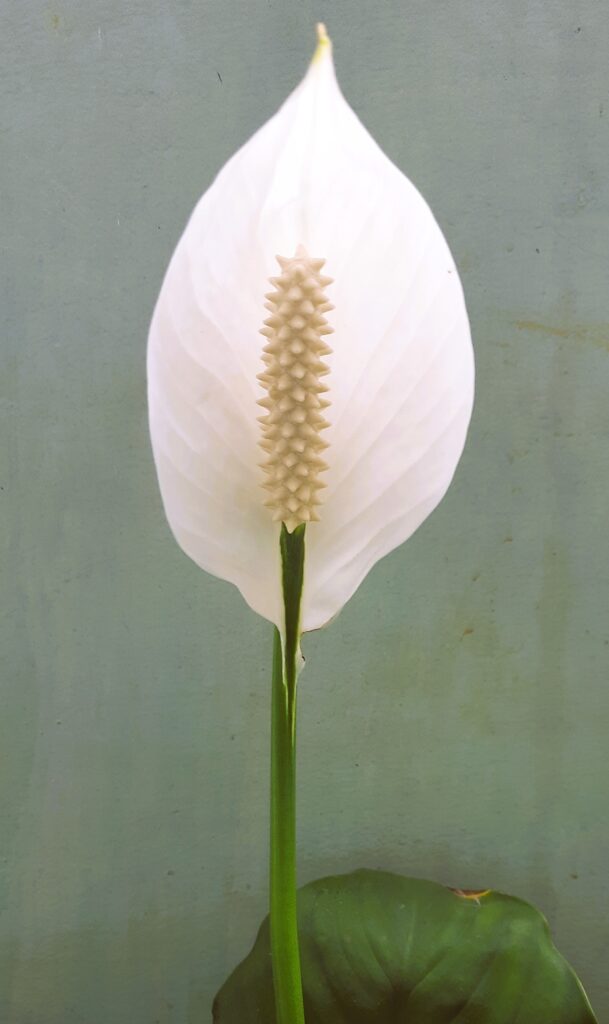
- Appearance: Peace Lilies have glossy, dark green leaves and elegant white flowers that resemble a white flag of peace, hence the name.
- Light: They prefer bright, indirect light but can tolerate lower light conditions. Avoid direct sunlight, as it can scorch the leaves.
- Watering: Keep the soil consistently moist but not soggy. Allow the top inch of soil to dry out before watering again. Overwatering or letting the soil stay too dry can lead to problems.
- Humidity: Peace Lilies thrive in high humidity but can tolerate average indoor levels. If the air is too dry, consider placing a humidifier nearby or misting the plant occasionally.
- Temperature: They prefer temperatures between 65-80°F (18-27°C). Avoid exposing them to temperatures below 50°F (10°C) in flower garden.
- Soil: Well-draining, high-quality potting mix is suitable for Peace Lilies. They are not particularly demanding in terms of soil type.
- Fertilizing: Feed the plant with a balanced liquid fertilizer every 6-8 weeks during the growing season (spring and summer).In flower garden, reduce or stop fertilizing in the fall and winter when growth slows.
- Pruning: Remove yellow or brown leaves and spent flowers to encourage new growth. Peace Lilies can benefit from occasional pruning to maintain their shape.
- Toxicity: Keep in mind that Peace Lilies are toxic to pets and humans if ingested. Keep them out of reach of children and pets.
- Repotting: Repot your Peace Lily if it becomes root-bound, generally every 1-2 years. Use fresh potting mix and a slightly larger container.
- Common Issues: Yellowing leaves can be a sign of overwatering, underwatering, or exposure to direct sunlight. Brown tips on the leaves may indicate dry air or over-fertilization.
ALLAMANDA:
- Allamanda is a genus of flowering plants in the dogbane family (Apocynaceae), and it includes several species commonly known as Allamandas.
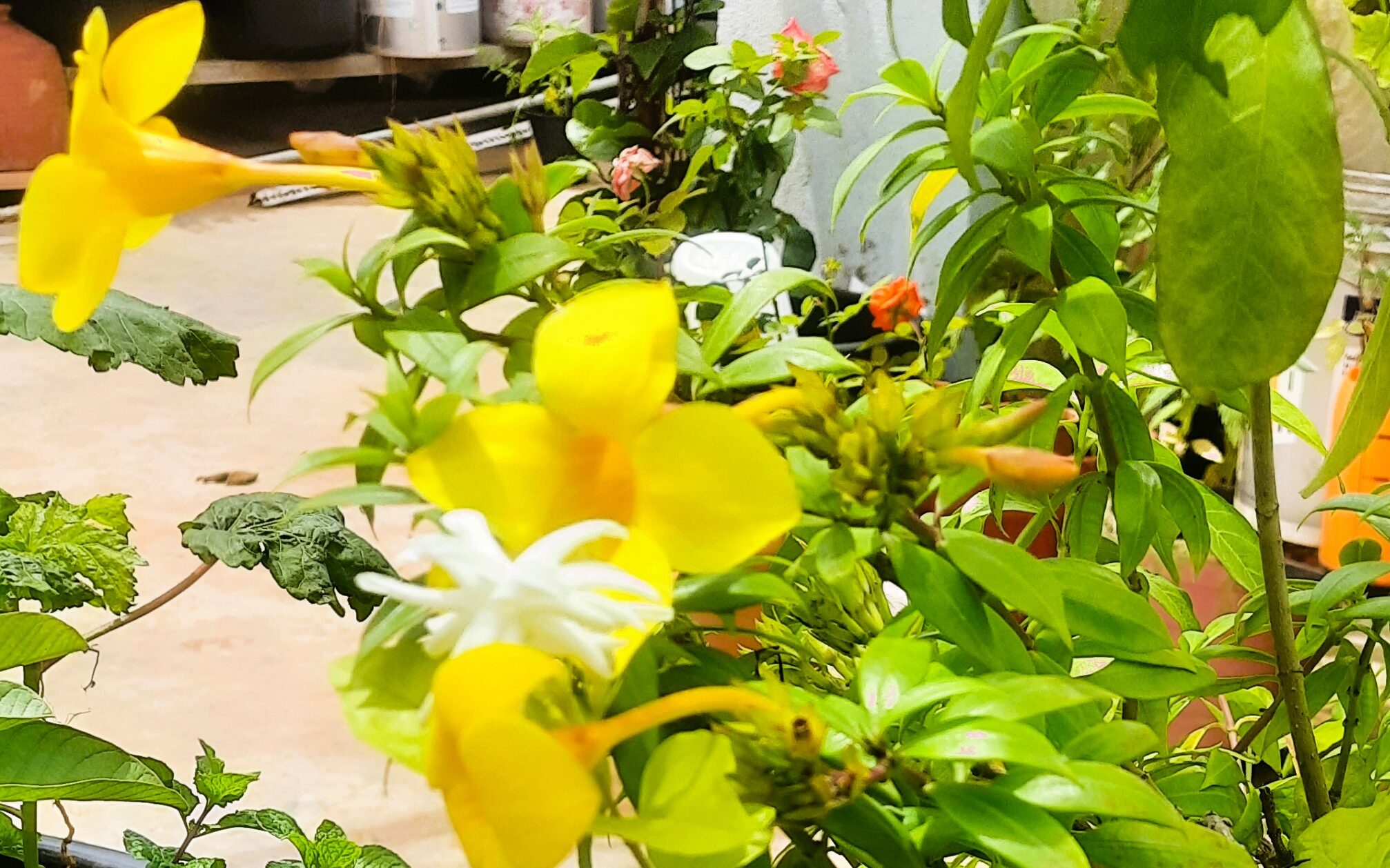
- Light: Allamandas thrive in full sun to partial shade. They prefer at least 4-6 hours of direct sunlight daily for optimal flowering. If grown indoors, place them near a bright, sunny window.
- Watering: Keep the soil moist but not over drained. Water the plant when the top of soil feels dry. During the growing season, water more frequently, and reduce watering in the winter when the plant is not actively growing.
- Soil: Use a well-draining, rich soil mix. A potting mix designed for tropical plants or a mix of potting soil and perlite works well.
- Temperature and Humidity: Allamandas thrive in warm temperatures between 60-80°F (15-27°C) and high humidity. They are tropical plants and should be protected from temperatures below 50°F (10°C).
- Fertilizing: Feed your Allamanda in your flower garden, with a balanced liquid fertilizer every 2-3 weeks during the growing season (spring and summer). Reduce or stop fertilizing in the fall and winter.
- Pruning: Prune your Allamanda to shape it and control its size. Pinch back the tips to encourage bushiness. Remove any dead or diseased branches. Wear gloves when pruning, as the sap can be irritating to the skin.
- Toxicity: All parts of the Allamanda plant are considered toxic if ingested. Keep it out of reach of children and pets.
- Pests and Diseases: Watch for pests like aphids, scale insects, and spider mites. Treat any infestations promptly with insecticidal soap or neem oil. Ensure good air circulation to prevent fungal diseases.
- Container Growing: Allamandas can be grown in containers, especially in colder climates where they can be brought indoors during the winter. Use a well-draining potting mix and ensure the pot has drainage holes.
- Propagation: Allamandas can be propagated through stem cuttings in flower garden. Take a 6-8 inch cutting with a few leaves, remove the lower leaves, and plant it in a pot with rooting hormone. Keep it in a warm, humid environment until roots develop.
ADENIUM:

- In flower garden, Adenium, commonly known as Desert Rose or Sabi Star, is a popular succulent plant known for its striking appearance and beautiful flowers. Here are some general care guidelines for Adenium:
- Light: Adeniums thrive in full sun. They need at least 6-8 hours of direct sunlight per day to produce the best blooms in the flower garden.. If cultivated indoors, place them near a sunny window.
- Watering: Adeniums are drought-tolerant plants but do require regular watering.Thoroughly water and allow the soil to dry before the next watering. During the growing season (spring and summer), water more frequently, and reduce watering in the winter when the plant is dormant.
- Soil: Employ a well-draining soil mix, preferably designed for cacti or succulents, enriched with perlite or sand to ensure proper drainage and prevent root rot.
- Temperature: Adeniums prefer warm temperatures and do not tolerate cold well. They are sensitive to temperatures below 50°F (10°C) and may suffer damage or die if exposed to frost. In cooler climates, consider growing them in containers that can be moved indoors during colder months.
- Fertilizing: Feed Adeniums with a balanced liquid fertilizer every 2-4 weeks during the growing season. Suspend or reduce fertilization in fall and winter when growth slows.
- Pruning: Prune your Adenium to shape it and encourage branching. Prune after flowering to maintain a compact and bushy shape. Wear gloves during pruning due to the potentially irritating sap.
- Potting: Use a container with drainage holes, and repot Adeniums every 2-3 years or when they outgrow their current pot. Be mindful of their succulent nature, and avoid overpotting.
- Pests and Diseases: Watch for common pests like aphids, mealybugs, and spider mites. Swiftly treat infestations with insecticidal soap or neem oil. Adequate airflow helps prevent fungal diseases in flower garden.
- Flowering: Adeniums produce spectacular, trumpet-shaped flowers in various colors. Flowering is influenced by factors such as sunlight, temperature, and age. Older plants tend to produce more blooms in flower garden.
- Propagation: Adeniums can be propagated from seeds or stem cuttings. Seeds take a longer time to mature into flowering plants, while stem cuttings can produce a more rapid result. Allow cuttings to callus for a day or two before planting them in a well-draining mix.
DIANTHUS:
Dianthus is a genus of flowering plants that includes a variety of species commonly known as pinks, carnations, or sweet Williams. These plants are known for their colorful and fragrant flowers in the flower garden. Here are some general care guidelines for Dianthus:
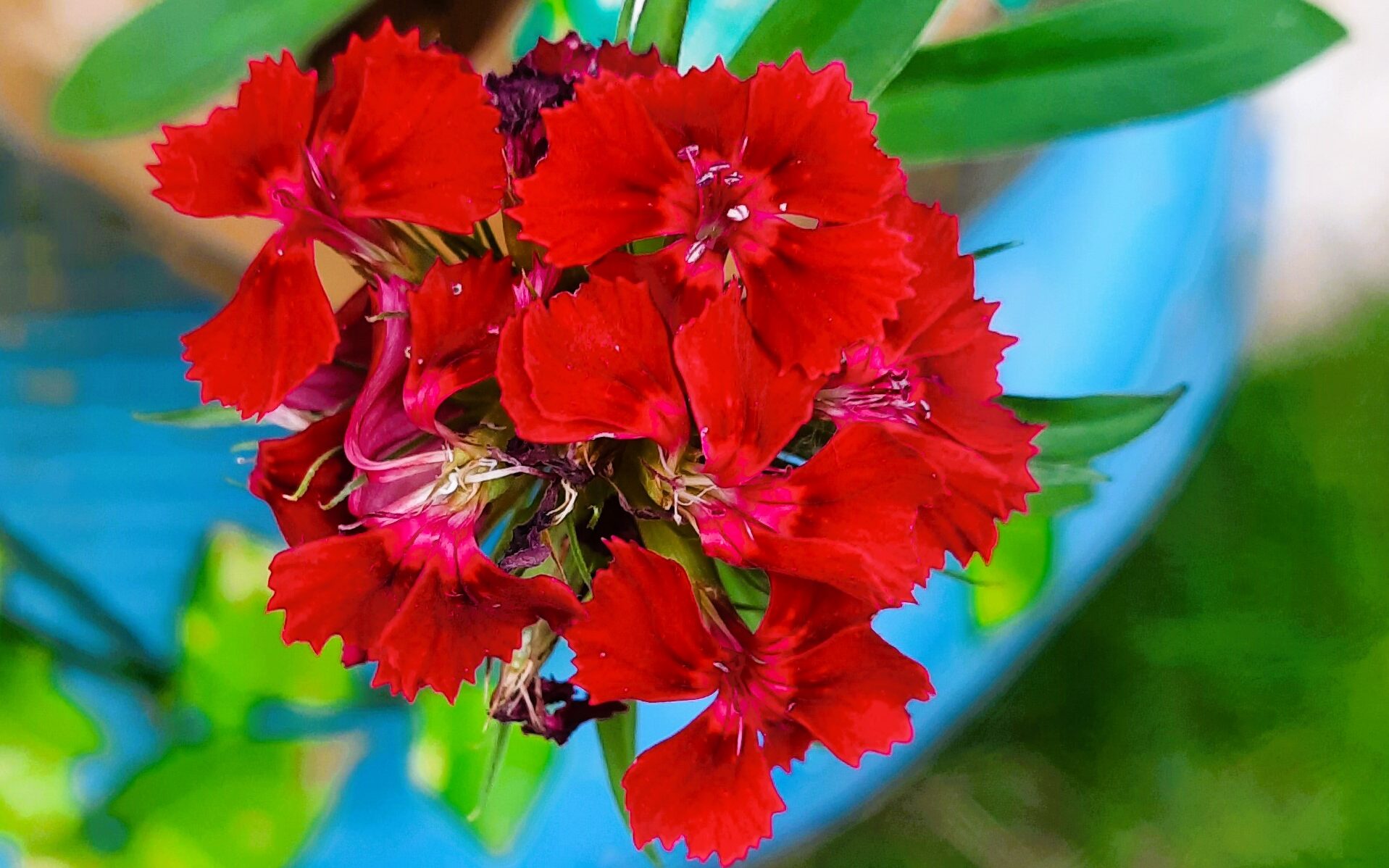
- Light: Dianthus plants generally prefer full sun. They will thrive in a location that receives at least 6 hours of direct sunlight per day. In hot climates, they can benefit from some afternoon shade.
- Soil: Dianthus prefers well-draining soil with a slightly alkaline to neutral pH. Good soil drainage is necessary to prevent roots rot. Amend heavy or clayey soils with organic matter to improve drainage.
- Watering: Dianthus plants prefer slightly moist soil. Water when the top inch of soil feels dry, but avoid overwatering, as they don’t tolerate soggy conditions well. Water at the base of the plant to keep the foliage dry and prevent diseases.
- Temperature: Dianthus is generally cold-hardy and can tolerate mild frost. However, they may struggle in extremely hot conditions. Ensure good air circulation around the plants to prevent heat stress.
- Fertilizing: Use a balanced, all-purpose fertilizer in the spring, following recommended rates. Avoid excessive fertilization to prevent leggy growth.
- Deadheading: Remove spent flowers regularly to encourage continuous blooming and prevent the plant from putting energy into seed production. This practice can also help maintain a neat appearance in flower garden.
- Mulching: Apply a light layer of mulch for moisture retention and weed suppression in flower garden.
- Pruning: Prune Dianthus plants after the main blooming period to promote bushier growth. Cut back the stems by a third, and remove any dead or yellowing foliage.
- Pests and Diseases:
- Monitor for pests like aphids and spider mites. Address promptly with insecticidal soap or neem oil. Ensure good air circulation to prevent fungal diseases in flower garden.
- Varieties: There are various species and cultivars of Dianthus, each with its unique characteristics. Some are perennial, while others are biennial or annual. Choose varieties that suit your climate and garden preferences.
YELLOW ALDER:
Yellow Alder, scientifically known as Turnera ulmifolia, is a flowering plant native to Mexico and parts of Central America flower gardens. It is a member of the passionflower family (Passifloraceae) and is also commonly referred to as “Sage Rose” or “West Indian Holly.”
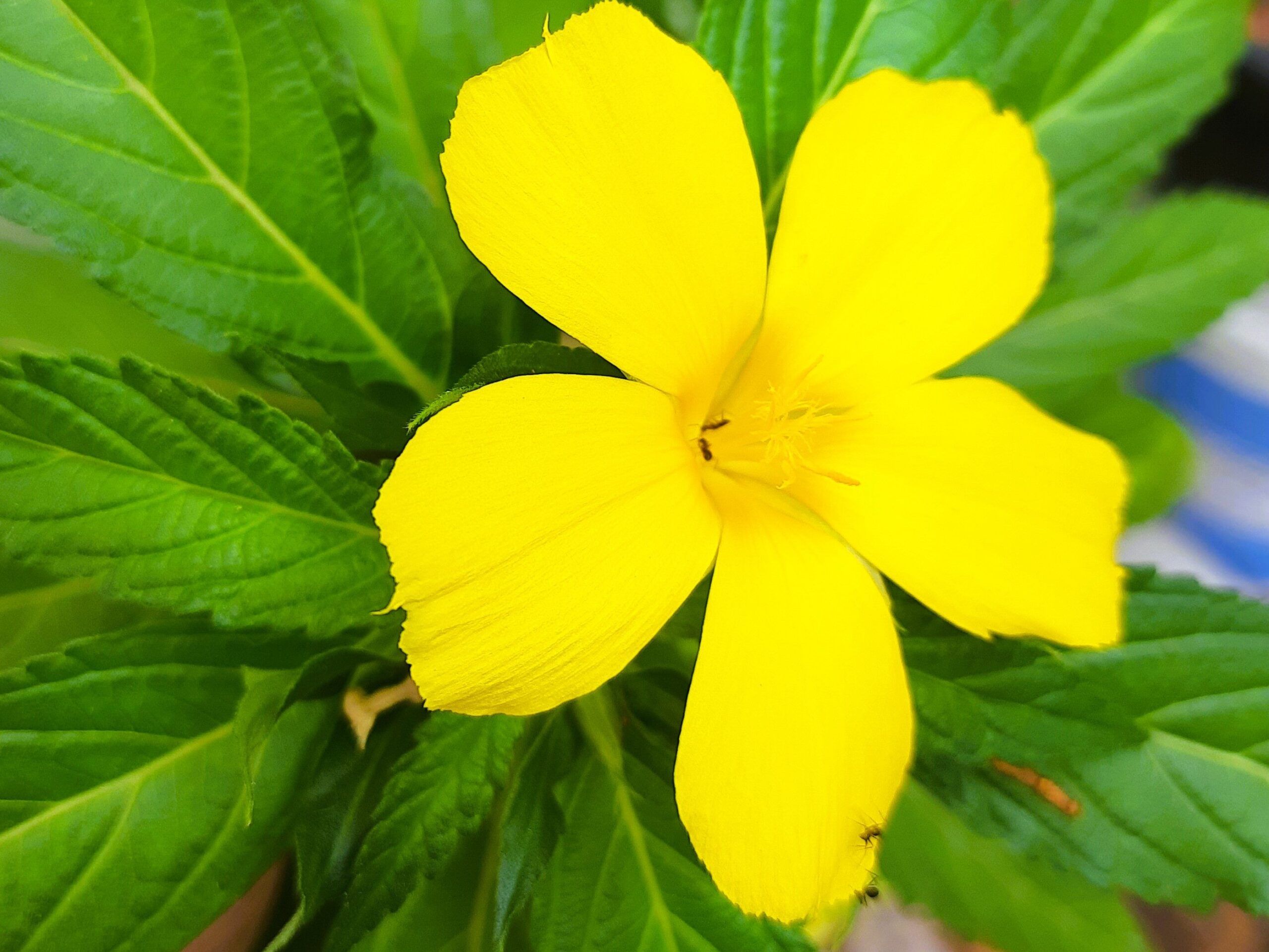
- Light: Yellow Alder thrives in full sunlight, requiring a minimum of 6 hours of direct sunlight per day for optimal growth and flowering. Some afternoon shade can be beneficial in intense heat.
- Watering: Provide regular watering, maintaining consistently moist soil without waterlogging. Water when the top inch of soil feels dry, and avoid overwatering to prevent root rot.
- Soil: Plant Yellow Alder in well-draining soil, adaptable to various types but emphasizing good drainage. Enhance fertility and drainage by incorporating organic matter.
- Temperature: While generally tolerant of warm temperatures, Yellow Alder may struggle in frost-prone areas.
- Fertilizing: Use a balanced, all-purpose fertilizer during the growing season, following recommended rates. Moderate fertilization is usually sufficient.
- Pruning: Prune Yellow Alder to shape and encourage bushy growth. Remove dead or leggy branches, and consider pruning after the flowering season for more blooms in the flower garden.
- Propagation: Yellow Alder can be propagated through seeds or cuttings. Sow seeds directly into the garden, or root stem cuttings in a well-draining mix.
- Pests and Diseases: Monitor for pests like aphids and whiteflies. Address infestations promptly with insecticidal soap or neem oil. Adequate airflow helps prevent fungal diseases.
- Flowers: Yellow Alder produces bright yellow, cup-shaped flowers with a prominent central stigma throughout the warmer months. They attract pollinators like bees and butterflies in the flower garden.
- Container Growing: Yellow Alder is suitable for container cultivation on patios or balconies. Ensure containers have drainage holes, use well-draining potting mix, and provide adequate support for plant growth in the flower garden.
Conclusion:
Flower garden are not only beautiful but also serve as spaces for relaxation, inspiration, and environmental awareness. They can be found in private residences, public parks, and dedicated botanical gardens around the world.
